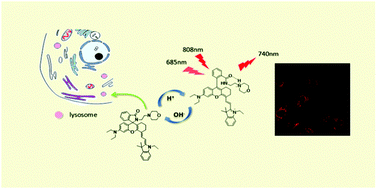A reversible frequency upconversion probe for real-time intracellular lysosome-pH detection and subcellular imaging†
Abstract
Lysosomal pH is known to be acidic, which plays a vital role in various processes in living organisms. Frequency upconversion luminescence exhibits the unique ability to convert low energy photons into high energy photons, which can be used in live samples due to its deep penetration, low tissue damage, etc. The development of sensitive frequency upconversion probes with a low pKa, high sensitivity, and specific selectivity for lysosomal pH detection is of great importance. Herein, we report a novel frequency upconversion luminescence probe, NRH-Lyso, by conjugating the rhodamine derivative NRH and the lysosome targeting functional group 4-(2-aminoethyl)morpholine. NRH-Lyso shows a sensitive response to acidic pH and excellent selectivity in the presence of metal ions, anions, and small molecules. Due to the structural transformation of lactam ring opening and closing of NRH-Lyso, the probe shows an almost 80-fold enhancement in emission intensity when the pH changes from 7.0 to 4.0 under 808 nm laser excitation. The living cell imaging data reveals that NRH-Lyso can selectively detect lysosomal pH changes with excellent photostability and low cytotoxicity. All these features make NRH-Lyso a good candidate to investigate the lysosomal pH-associated physiological and pathological processes.



 Please wait while we load your content...
Please wait while we load your content...